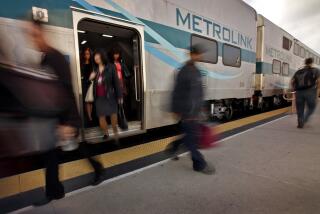The Fight Against Crime: Notes From the Front : Train Deaths Affect Others as Well as Victims
- Share via
Every time someone ends it all by jumping in front of a speeding Metrolink train, every time a reckless motorist or unwary pedestrian gets smashed by a locomotive, Edward Pederson has to look at the results.
As safety manager for Metrolink, Pederson is responsible for educating the public about the dangers of the tracks and enforcing track rules.
He is also in charge of in-house investigations of train-track deaths, which start with him looking for what’s left of the victims.
“I think people don’t respect the train tracks, that’s my bottom line,” Pederson said. “A death doesn’t just affect one life, it affects other people’s lives.”
Since Metrolink service began in 1992, 30 people have died on the rails, with 12 deaths classified as suicides.
The problem is usually a fatal miscalculation, Pederson said. Someone sees a crossing gate coming down and thinks he can drive around it before the train gets there. Or someone thinks that any convenient place to cross the tracks is as good as any marked crossing.
“Trains are unpredictable,” Pederson said. “They can come on either track at any time. We try to make people aware of the fact that tracks are for trains, not people.”
Those who attempt to challenge the trains will lose, he said. A Metrolink locomotive weighs 132 tons. Each car comes in at about 96 tons. Average train length is four cars and one locomotive--or more than 500 tons.
Even if an engineer sees a stalled car or unaware person on the tracks, at Metrolink’s average speed of 60 m.p.h., it can take more than a third of a mile to stop, Pederson said.
Pederson recalls his most troubling cases: a grandfather, daughter and granddaughter in Glendale who died taking a shortcut across the tracks; a bicyclist in Sunland, who thought he could make it around the closed gates.
“The gates were down for a reason, the lights were going, the crossing was making a noise for a reason, but he decided he could beat the train and went around for whatever reason,” Pederson said. “Why? And I’ll never know.”
Then there are the suicides. All the educating in the world about track safety won’t stop those who want to die in dramatic fashion in front of a train. What they don’t consider, he said, are the other people they affect: the engineer who feels helpless, the witnesses who feel traumatized.
A few weeks ago, Pederson recalled, a 30-year-old man leapt in front of a train within view of a schoolyard full of children. “There are other ways to deal with that pain, to deal with that anger he might have had,” Pederson said. “He took it out on other people.”
After each death, Pederson heads to the scene to find out if required procedures were followed, if the engineer blew the train whistle, if the engine’s headlights were on, if crossing gates worked properly.
He interviews the crews and engineer to see if anyone needs counseling and, if there is any suspicion, orders immediate drug and alcohol tests for the train crew.
Pederson also tries to see if there is anything Metrolink can learn from the incident, or any way to modify the track area--such as putting up new barriers or gates--that would lessen the chances for future accidents.
“It kind of tugs at you,” said Pederson, who worked in a hospital emergency room for 10 years as a registered nurse. “I look at how the engineer is affected, because he saw what happened and he feels helpless. How does the engineer deal with that, not only today but next week and next year?”
A big part of Pederson’s job is working to prevent train deaths. He runs programs for children, teaching them to “Look, listen and live.”
Adult promotions encourage people not to “pick a fight with a heavyweight.”
“If there was a 0% accident rate, if there was a 0% injury rate, then I wouldn’t have a job,” Pederson said. “But unfortunately human nature and accident rates tell me that I’m going to have a job.”
Dismally far into the future, it appears.
More to Read
Sign up for Essential California
The most important California stories and recommendations in your inbox every morning.
You may occasionally receive promotional content from the Los Angeles Times.










